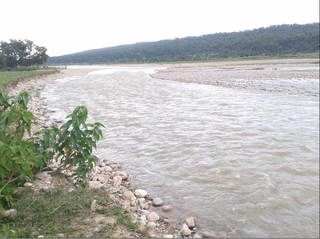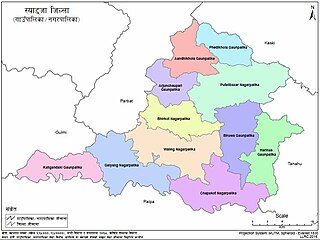Chisapani may refer to several places in Nepal:
Chisapani may refer to several places in Nepal:

The Ghaghara River, called Karnali River in Nepal, Mapcha Tsangpo in Tibet, and the lower Ghaghara in Awadh called Sarayu River, is a perennial trans-boundary river that originates in the northern slopes of the Himalayas in the Tibetan Plateau, cuts through the Himalayas in Nepal and joins the Sharda River at Brahmaghat in India. Together they form the Ghaghara River, a major left bank tributary of the Ganges. With a length of 507 km (315 mi) it is the longest river in Nepal. The total length of Ghaghara River up to its confluence with the Ganges at Revelganj in Bihar is 1,080 km (670 mi). It is the largest tributary of the Ganges by volume and the second largest by length after Yamuna.
Puma is a Kiranti language spoken by about 4,310 people in Sagarmatha Zone, Nepal. The actual population may be somewhat higher. The same term ‘Puma’ refers both to the people and the language they speak [Sharma 2014].

Helambu is a region of highland villages in Nepal, about 80 km from Kathmandu. It is the home of the Hyolmo people. The word Hyolmo derives from the word Helambu. The Helambu region begins at the Lauribina La pass and descends to the Melamchi valley. Helambu is famous for its sweet apples. and artistic Buddhist monasteries and it is a Buddhist pilgrimage site.

Mahendra Highway, also called East-West Highway runs across the Terai geographical region of Nepal, from Mechinagar in the east to Bhim Datta in the west, cutting across the entire width of the country. It is the longest highway in Nepal and was constructed by cooperation of various countries. The highway is named after king Mahendra Shah.
Chisapani is a village in Banke District in Lumbini Province of south-western Nepal, not to be confused with Chisapani in the bank of Karnali River.
Chisapani is a town and Village Development Committee in Ilam District in the Province No. 1 of eastern Nepal. At the time of the 1991 Nepal census it had a population of 3,444 persons living in 650 individual households.
Chok Chisapani is a village development committee in Tanahu District in the Gandaki Zone of central Nepal. At the time of the 1991 Nepal census, it had a population of 4614 people living in 462 individual households.
Rupakot is a village development committee in Tanahu District in Gandaki Province of central Nepal. At the time of the 1991 Nepal census it had a population of 4765 people living in 937 individual households. The VDC has been merged with existing Bhanu village development committees(VDCs), Barbhanjyang village development committees (VDCs) Tanahunsur Village Development Committee, Purkot VDC, Mirlung VDC, Satiswara VDC, Risti VDC, Basantapur VDC and Chok Chisapani VDC on 19 September 2015 to form Bhanu Municipality.
Chisapani, Ramechhap is a village development committee in Ramechhap District in the Janakpur Zone of north-eastern Nepal. At the time of the 1991 Nepal census it had a population of 3,058 people living in 579 individual households.

The Kamala River originates from Nepal and flows through Indian state of Bihar.
Pramila Rijal is a Nepalese track and field athlete who represented Nepal at the 2012 Summer Olympics in the women's 100 metres. She also competed at the 2009 Asian Athletics Championships, running in the heats of the 200 metres and 400 metres.

Karnali Bridge, the asymmetric, single-tower, cable-stayed bridge is the second longest of its type in Nepal and was built by international collaboration between USA, Japan and Nepal.
Bardaghat [नेपाली: बर्दघाट] is a Municipality in Parasi District in Lumbini Province, Nepal. It is situated in the lap of Chure range. This municipality was established on 18 May 2014 by merging existing Makar and Panchanagar VDCs. Again during the local election, the neighbouring VDC Dawanne devi and some part of Dhurkot, Jamuniya, Rupauliya were merged in it. It has a population of 55,382 with the area of 162.05 km2. It is an emerging town of Parasi District that is developing rapidly.

Santosh Lamichhane is a Nepali writer. He has authored a Nepali poetry collection, Porridge Eaters and Gruel Drinkers and a Nepali novel Ultimate Aakash.

Bhanu is a municipality of Tanahun District in Gandaki Province of western Nepal. The municipality was established on 19 September 2015 by merging the existing Bhanu village development committee or VDC, Barbhanjyang VDCs, Rupakot (VDC), Tanahunsur Village Development Committee, Purkot VDC, Mirlung VDC, Satiswara VDC, Risti VDC, Basantapur VDC and Chok Chisapani VDC. The center of the municipality is established in former VDC Office of Bhanu. After merging the population of all of the VDCs, it had a total population of 46,179 according to 2011 Nepal census. After the government decision the number of municipalities has reached 217 in Nepal. Nepali poet Bhanubhakta Acharya was born in Bhanu Municipality. It was named after him.
Janapriya Higher Secondary School, formerly Janapriya Secondary School, is a community-run non-profit higher secondary school in Hetauda, known for its technical education program in veterinary and agriculture, which is referred to, independently, as Janapriya Technical School. It is designated as one of the model public schools of the country by the federal government of Nepal.

Harinas is a Village council in Syangja District in Gandaki Province, central Nepal.
Mai is a municipality out of four municipalities of Ilam District of Province No. 1 of Nepal. It was formed in May 2017 with merging some VDC. Mahamai, Danabari and Chisapani VDCs were merged. The municipality is divided into ten wards which is surrounded by Deumai Municipality and Ilam Municipality from north, Suryodaya Municipality from north-east, Jhapa District from south-east and Mangsebung and Chulachuli Rural Municipality from west.
Jantedhunga is a rural municipality (gaunpalika) out of eight rural municipality located in Khotang District of Province No. 1 of Nepal. There are a total of 10 municipalities in Khotang in which 2 are urban and 8 are rural.
Mahashila Rural Municipality is a Gaunpalika in Parbat District in Gandaki of Nepal. On 12 March 2017, the government of Nepal implemented a new local administrative structure, with the implementation of the new local governance structure, Village Development Committees have been merged to form Municipalities and Gaunpalikas.